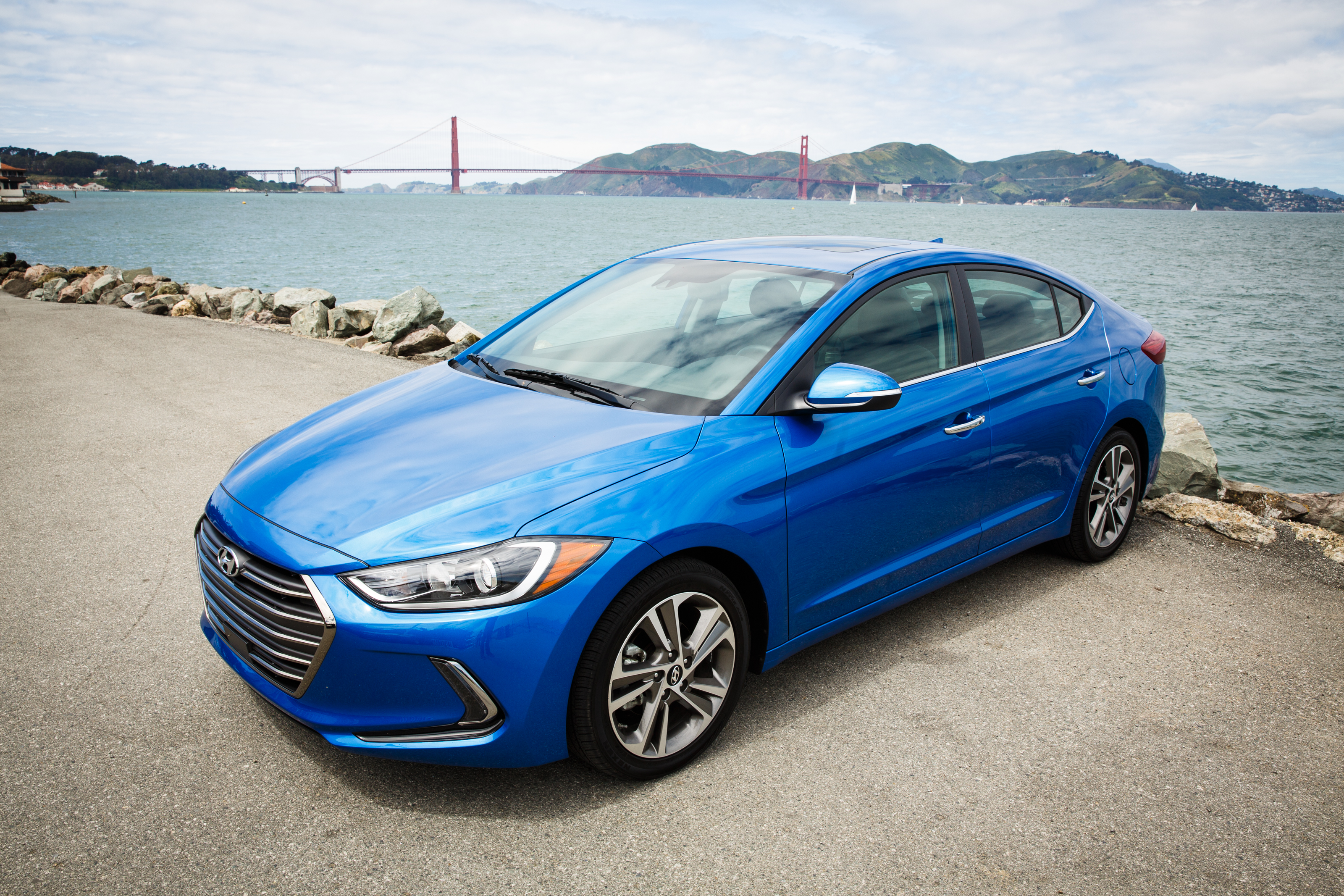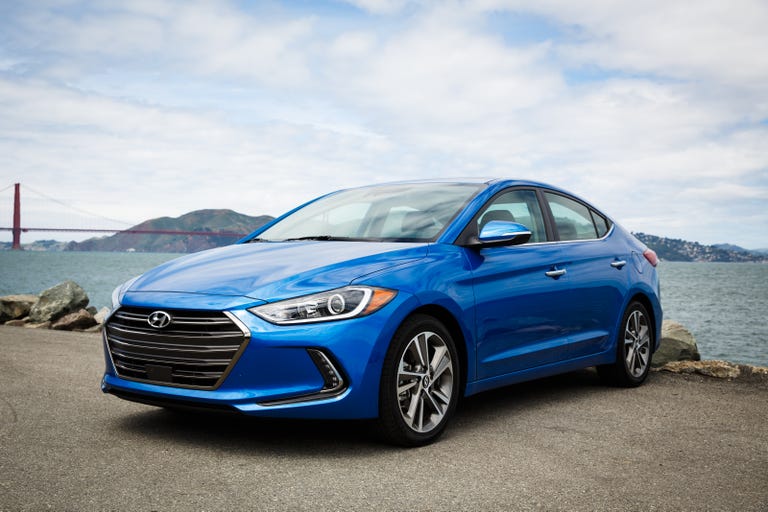 Why You Can Trust CNET
Why You Can Trust CNET 2017 Hyundai Elantra review: Hyundai's jumbo compact sedan communes with Google
Technically a midsize sedan, the new Hyundai Elantra sports plenty of passenger room and a navigation system integrating Google search.
With its arched roofline sloping all the way back to the trunk lid, the 2017 Hyundai Elantra almost looks like a hatchback. And that's just one of the deceptively odd things about Hyundai's small sedan.
The Good
The Bad
The Bottom Line
If you are familiar with older Elantras, you might expect this car to be compact, but it actually classifies as a midsize car according to EPA definitions. Having gained almost an inch in length and a bit more in width, the 2017 Elantra looks and feels larger inside and out.
What really threw me as I drove the new Elantra and examined its spec sheet was the engine. Four cylinders, displacing 2.0 liters, has been pretty standard fare for cars of this size, but Hyundai also notes that this engine uses an Atkinson cycle, a valve timing scheme most often used in hybrids. What is going on here?
Hyundai gave the Elantra sedan a major update for the 2017 model year, with new styling, chassis, engine and electronics. This car slots under the Sonata, Hyundai's larger midsize sedan. I drove a fully loaded Limited-trim version, pricing out at over $27,000 and a big step ahead in features compared to the base SE model. Hyundai will add an Eco model with a smaller, turbocharged engine later this year.

The Elantra's interior dimensions make it a midsize sedan, according to EPA categorization, meaning a roomier cabin for passengers.
Atkinson diet
In city driving, the Elantra pulled just fine up to about 25 mph, but above that I felt it struggle, especially going uphill. At 147 horsepower and 132 pound-feet of torque, the engine's output is in line with typical four-cylinder engines, but the valve timing gives it a slight different character. Atkinson cycle engines leave their intake valves open longer than does a conventional engine, allowing a more complete fuel burn.
While this cycle makes more efficient use of fuel, it generally results in lower torque. Hence, Atkinson cycle engines see the most use with hybrid drivetrains, where electric propulsion can make up for power deficiencies.
In the Elantra, the Atkinson cycle mainly affected acceleration. I was able to hum along on the freeway at 65 mph without a problem, but when I contemplated passing maneuvers, I had to take some more care. The car's six-speed automatic transmission did its best to give me power when I needed it, but its behavior meant more gear changes, which some might describe as "hunting."
The Elantra proves the Atkinson cycle's efficiency, however, with fuel economy ratings of 28 mpg city and 37 mph highway. Those number proved realistic, as I found a consistent mid-30s fuel economy in city and freeway driving.
Over bumps, the suspension felt bouncy as it tried to maintain a comfortable ride quality, but sound deadening improved the overall in-cabin experience. The steering felt reasonably responsive, with a strong pull to center. However, the tuning of this electronic power system wasn't particularly natural.
The Elantra serves well for transportation, but doesn't make for a lot of fun behind the wheel.
I wouldn't call the new Elantra a driver's car, but most people will find it a comfortable and economical means of getting to work and running errands.
Tech package upgrade
While the Elantra's driving dynamics should span all trims, moving up to the Limited model and adding the Tech package brings in navigation on an 8-inch touchscreen with support for Apple CarPlay and Android Auto.The touchscreen, larger than on most cars of this class, also shows digital audio sources as well as phone features.
The car's native navigation system shows maps with a clean design and very extensive traffic coverage, with flow information for many surface streets as well as freeways. Although the maps lack a perspective view, only showing a top-down format, I was pleased to find Google search integrated with the destination options. Using it, I entered a search term and quickly got a list of any businesses with that term in the name.
Likewise, Hyundai's Blue Link telematics service lets owners look up destinations using Google on a PC and send them to the car.
The Elantra's 8-inch touchscreen is bigger than most in this segment.
The Elantra's audio system came with the standard list of digital sources, including satellite radio, Bluetooth streaming and a USB port. One clever addition is SoundHound integration. Using it while listening to the radio, I pressed a button and SoundHound sampled the current track, compared it to its online database, then returned the track name and artist. The SoundHound service works well, but ultimately didn't prove that useful for me, as the radio and iPhone sources I tend to use already have that information handy.
I spent some time running Apple CarPlay in the Elantra, which worked much like other Apple CarPlay implementations. There is a convenient Hyundai icon on the CarPlay homescreen, which let me quickly get back to Hyundai's native apps. The CarPlay connection crashed on me a couple of times when I was running navigation and also receiving text messages. Whether that's the fault of Hyundai's implementation or Apple CarPlay itself, I couldn't say.
Ultimate tech
Upping the tech features in this Elantra -- and the price -- was what Hyundai calls the Ultimate package, bringing in dynamic headlights that point into turns, adaptive cruise control which automatically matches speeds with slower traffic ahead, and a lane-keeping assist system to keep the car from drifting across lane lines.
I spent quality time on the freeway, letting the adaptive cruise control take care of braking and acceleration, giving my right leg a rest. However, my fellow Roadshow editor Emme Hall found the system didn't work very well in slower traffic.
Hyundai gives the 2017 Elantra an attractive design, with a roofline that curves down through the trunk lid.
The lane-keeping system offered a few different settings, the highest aggressively moving the the steering wheel to keep the car from drifting. In its mid-setting, where I spent the most time, it was not intrusive at all.
The driver-assist feature that impressed me most, the blind-spot monitor, actually comes standard with the Limited trim. Along with showing an icon on the side mirrors to warn me of cars in the lanes next to me, the system also detected a cyclist in a bike lane, warning me that it wasn't safe to make a right turn.
The scrum
The 2017 Hyundai Elantra lives in a very aggressive segment, competing with very popular cars such as the Toyota Corolla, Nissan Sentra and Honda Civic. All of these cars boast base prices well under $20,000, and many in this segment have made the jump from the Compact to Midsize class, giving them ample passenger and cargo room.
Similarly, many of these cars can be optioned up with driver-assist systems and connected features that used to only be available in the premium or luxury segments.
Optioned all the way up, this Elantra came in at $27,710 with destination, a pretty big jump from its base price. However, the driving dynamics will fit the needs of most people, and the fuel economy is very competitive with the segment. The electronics, both for driving and infotainment, are a big bonus here. Hyundai implements them well, making them easy to use for a modern buyer.


